- Home
- Publications et statistiques
- Publications
- Monthly Business Survey – April 2023
The Banque de France publishes a range of monthly and quarterly economic surveys that provide a snapshot of the French economy in the form of business climate indicators and short-term forecasts.
In the first quarter of 2023, activity proved resilient. According to the business leaders surveyed (approximately 8,500 companies and establishments questioned between 29 March and 5 April), activity rose in March in industry, services and construction.
For April, business leaders expect activity to improve further in industry and services, but to decline in construction.
Supply difficulties continued to ease in construction (20% of businesses reported difficulties in March, down from 24% in February) and in industry (30% of business leaders reported difficulties, down from 33% in February). Raw material prices were deemed stable in March. Business leaders also indicated a slowdown in finished goods prices, except in the agri-food industry where price growth remained strong. Recruitment difficulties remained stable, affecting around half of surveyed businesses (52%).
Our uncertainty indicator was unchanged on the previous month in all three major sectors, and remains high compared with pre-2020 levels. Cash positions improved for the second consecutive month in industry, but deteriorated in services.
Regarding the consequences of the energy situation, business leaders’ opinions were stable, with 29% indicating that it would affect their activity over the next three months (29% in February and 33% in December); in industry the share continued to decline (32% compared with 40% in December).
Based on the survey results as well as other indicators, we estimate that GDP growth should be around 0.2% for the first quarter of 2023 compared with the previous quarter. This upward revision can be mainly attributed to the improvement in INSEE’s industrial production index for February and its services production index for January.
1. In March, activity increased in industry, services and construction
In March, activity increased in industry. Balances of opinion indicate that production rose markedly in computer, electronic and optical products, aeronautics, machinery and equipment, and the automotive industry. In contrast, production fell markedly compared with the previous month in chemicals, agri-food and wood, paper and printing.
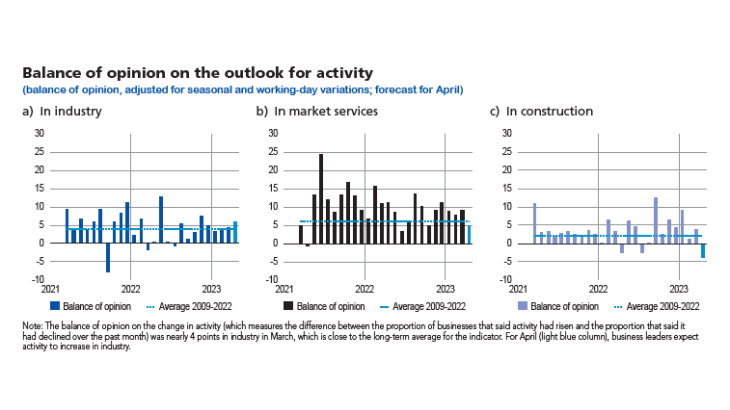
Inventories were little-changed in March but continued to be deemed above their long-term average.
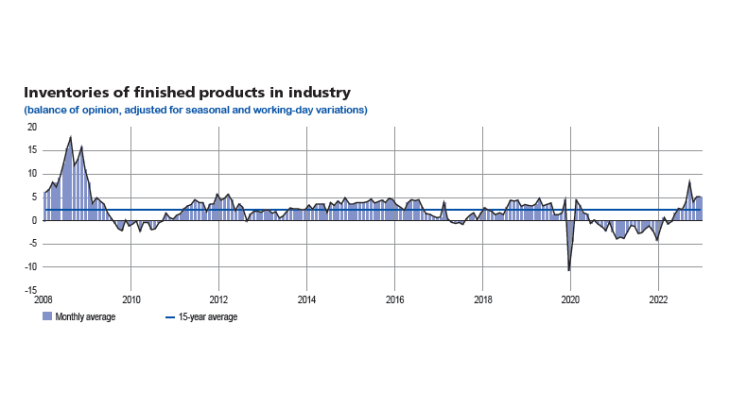
In market services, activity continued to expand at a robust rate. The rise was particularly strong in car rental services, and in the majority of business services (management consultancy, legal and accounting activities, technical services). In transportation and storage, activity contracted for the third consecutive month, especially with the impact of industrial action. The strikes also caused activity in food services to stabilise, whereas business leaders said last month that they were expecting it to rise. In accommodation services, activity remains robust at this stage, but a portion of business leaders voiced concerns over the coming season.
Activity improved in construction, mainly thanks to a strong performance in finishing works. The outcome was better than anticipated by business leaders in last month’s survey.
For the second month in a row, the balance of opinion on cash positions improved slightly in industry, while still remaining below its long-term average. The improvement was more marked in aeronautics, computer, electronic and optical products, and pharmaceuticals. It deteriorated again in services in March, especially in food services.
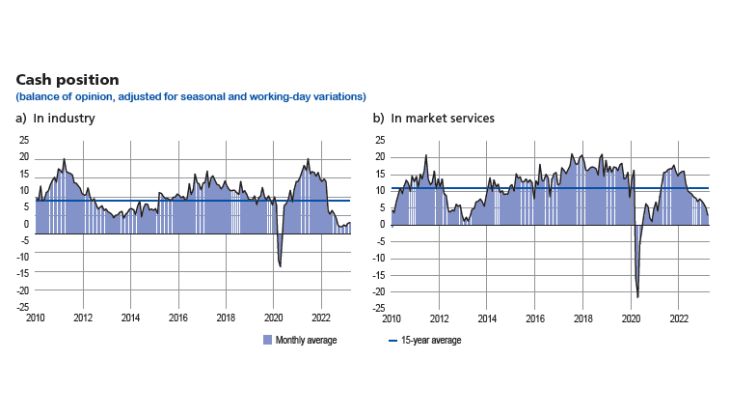
2. In April, business leaders expect activity to rise further in industry and services, but to decline in construction
For April, business leaders in industry expect activity to rise in all sub-sectors. The strongest growth is expected in aeronautics, chemicals, pharmaceuticals, and computer, electronic and optical products.
In services, business leaders are continuing to forecast a rise in activity in all sub-sectors, with the exception of advertising, and transportation and storage.
Lastly, in construction, activity is expected to fall in both structural and finishing works.
Our monthly uncertainty indicator, which is constructed from a textual analysis of comments by the respondent companies, remained little-changed in March; it has stabilised at close to twice its average pre-Covid level.
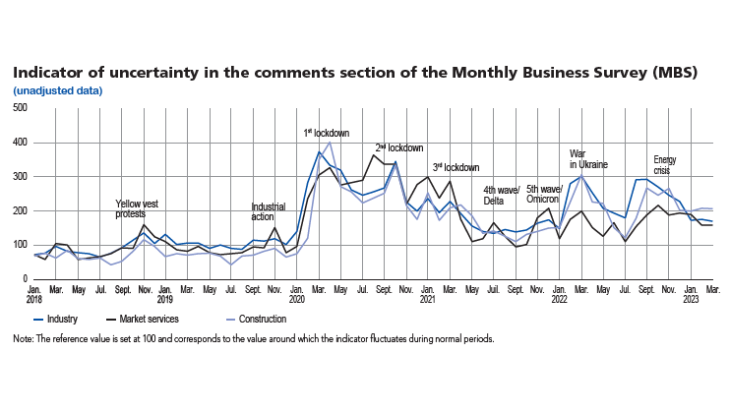
In industry, the balance of opinion on order books stabilised at close to its 15-year average, although with a strong polarisation between sub-sectors where order books were deemed to be well-stocked (automotive industry, aeronautics, computer, electronic and optical products, wearing apparel) and those where they were deemed abnormally low (agri-food, chemicals, wood, paper and printing, rubber and plastic products). In construction, the deterioration in order books since mid-2022 is exclusively attributable to structural works which is being hit by the sharp drop in sales of new houses; order books in finishing works have been stable for the past ten months, thanks to energy renovation work.
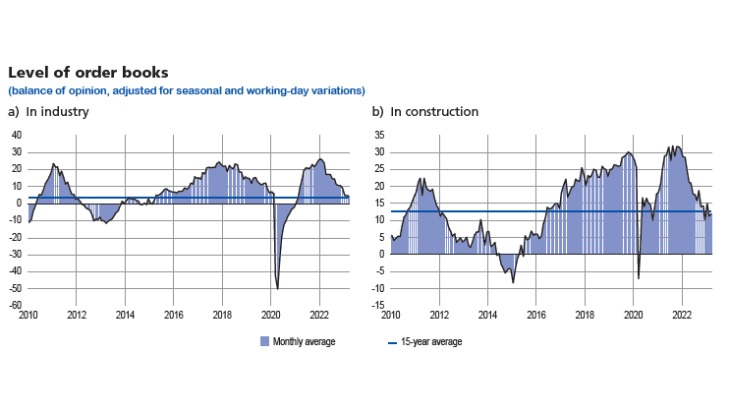
3. Supply difficulties continued to subside; growth in finished goods prices slowed further.
In March, supply difficulties subsided in industry (affecting 30% of businesses after 33% in February) and in construction (20% after 24%).
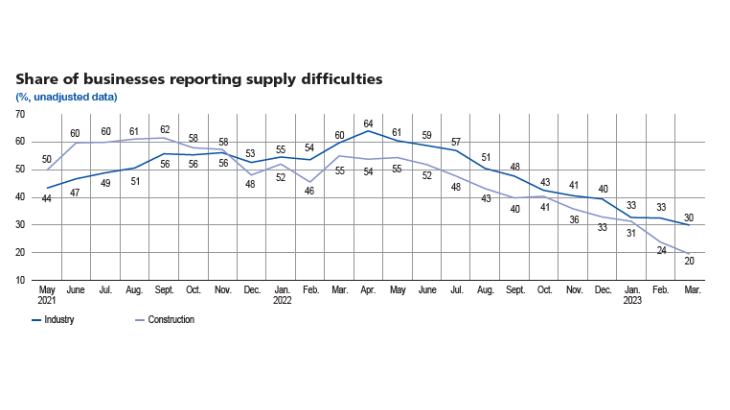
According to the business leaders surveyed in industry, raw material prices were stable overall in March, but this masks contrasting trends across sub-sectors: in the agri-food and aeronautics industries, input prices continued to rise at a high pace, whereas in rubber and plastic products and in wood, paper and printing, input prices declined significantly. Growth in finished goods prices is also slowing in industry, but more gradually. In construction, prices slowed markedly as falling demand led to heightened competition. In services, however, business leaders said prices rose slightly faster than in the previous month.
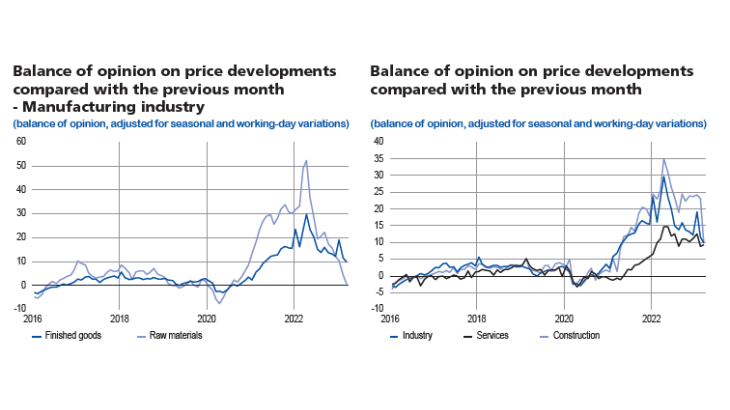
More specifically, 22% of business leaders said they had raised their selling prices in industry in March (compared with 44% in March 2022). As price talks between large general retailers and agri-food firms take place on 1 December and 1 March each year, the proportion of business leaders that said they had raised their prices in this sub-sector was 52% (compared with 60% in March 2022), which was in line with expectations last month. In construction, 29% of businesses said they had raised their prices in the past month (54% in March 2022). In services, the proportion was smaller, but close to that observed a year earlier (19% after 22% in March 2022). The outlook for April points to a further slowdown in price growth in industry and market services (11% and 16% of businesses respectively said they expect to raise their prices), and a stabilisation in construction (29%).
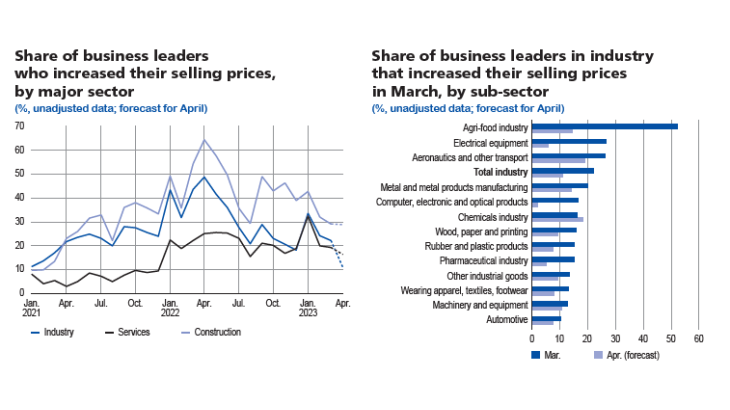
Business leaders were also asked about their recruitment difficulties. After easing for several months, they remained stable in March, affecting around 52% of businesses in all sectors combined.
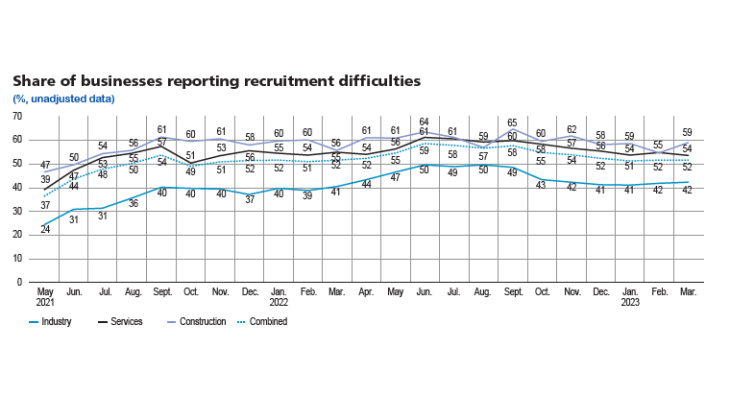
4. Estimates primarily derived from the survey, supplemented by other indicators, point to GDP growth of around 0.2% in the first quarter
Despite the increase in manufacturing industry output reported by business leaders, value added in the overall industrial sector is expected to have fallen sharply in March. This can be attributedto non-manufacturing sub-sectors such as coking and refining, electricity production and waste management, which are not covered by the survey but which we monitor using high-frequency indicators; activity in these sub-sectors has been significantly affected by industrial actions over the past month.
Value added in market services is also expected to have dropped in March. In those services covered by the survey, value added is predicted to have risen in March, with both personal services and business services all expected to have seen growth. However, the high-frequency data that we monitor in parallel for those services excluded from or only partially covered by the survey suggest that value added fell in wholesale and retail trade and in transport services, which were all affected by industrial actions.
Construction is expected to have seen a rise in activity in March.
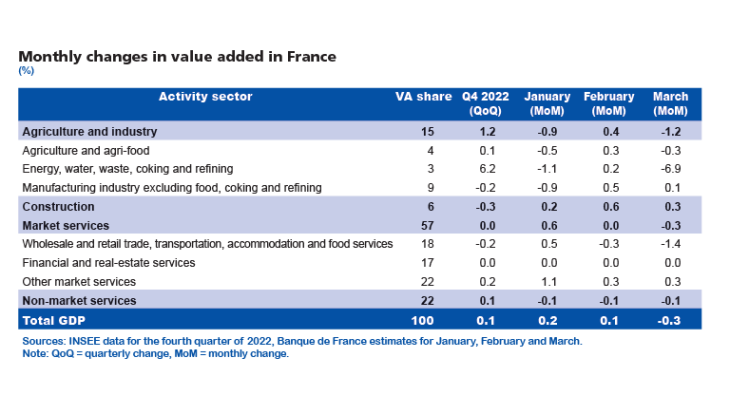
At this stage, business leaders’ forecasts for April suggest GDP will expand overall compared with March, although again with contrasting performances across sectors (fall in construction, rise in services and sharp rebound in industry). These forecasts also remain shrouded in significant uncertainty.
Over the first quarter of 2023, we expect GDP to grow at around 0.2% compared with the previous quarter. It is estimated to have been supported by strong activity in industry and market services over the first two months of the year, as suggested by the marked rises in the February industrial production index and the January services production index, which were recently published by INSEE.
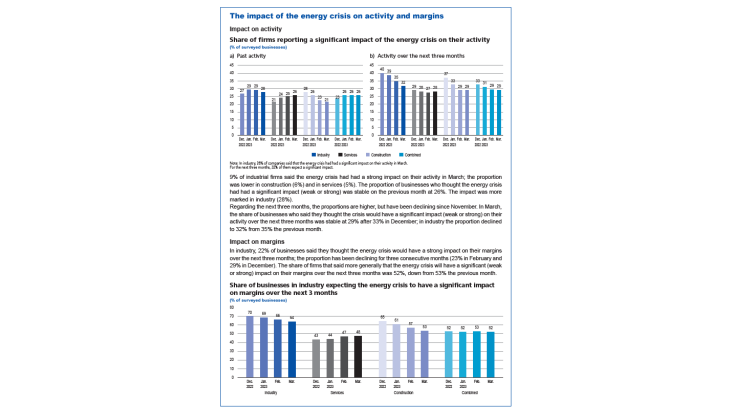
Download the PDF version of this article
Updated on the 25th of July 2024